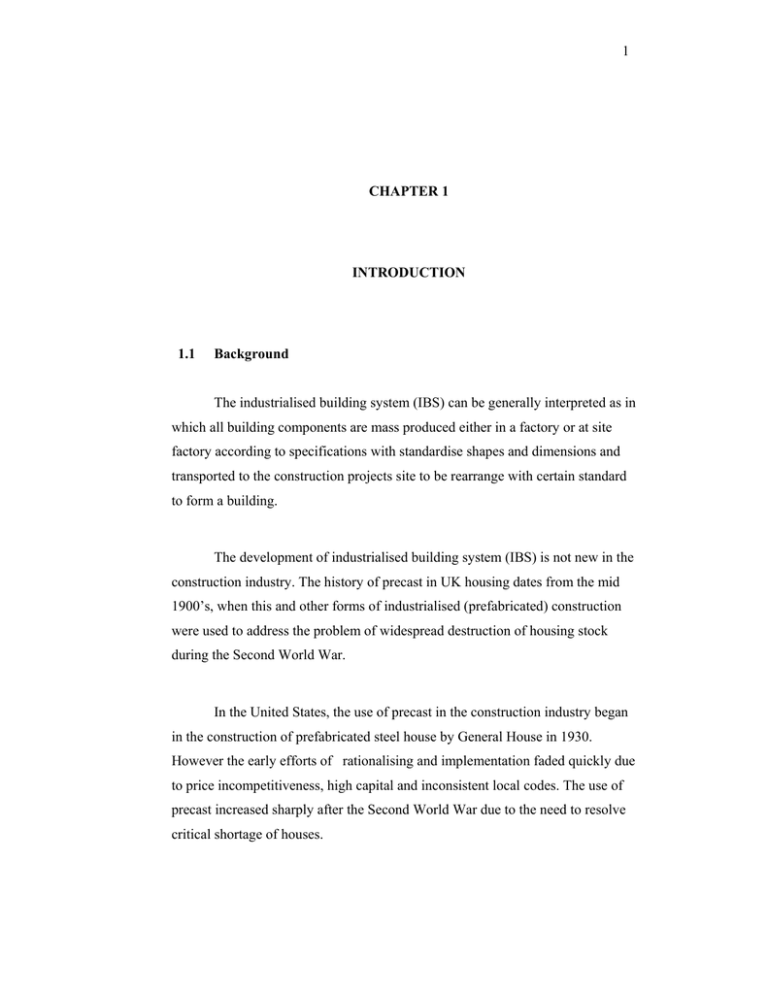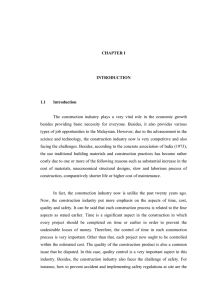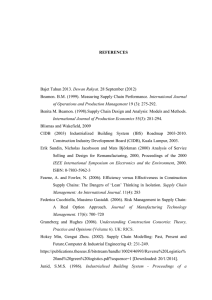1 The industrialised building system (IBS) can be generally interpreted as... which all building components are mass produced either in a...
advertisement

1 CHAPTER 1 INTRODUCTION 1.1 Background The industrialised building system (IBS) can be generally interpreted as in which all building components are mass produced either in a factory or at site factory according to specifications with standardise shapes and dimensions and transported to the construction projects site to be rearrange with certain standard to form a building. The development of industrialised building system (IBS) is not new in the construction industry. The history of precast in UK housing dates from the mid 1900’s, when this and other forms of industrialised (prefabricated) construction were used to address the problem of widespread destruction of housing stock during the Second World War. In the United States, the use of precast in the construction industry began in the construction of prefabricated steel house by General House in 1930. However the early efforts of rationalising and implementation faded quickly due to price incompetitiveness, high capital and inconsistent local codes. The use of precast increased sharply after the Second World War due to the need to resolve critical shortage of houses. 2 In Malaysia, the implementation of precast concept by using precast concrete building were introduced in Malaysia in 1966 when the government launched two pilot projects for precast housing which involves the construction of Tuanku Abdul Rahman Flats in Kuala Lumpur and the Rifle Range Road Flats in Penang. Both projects were the first time whereby precast elements were used to construct mass houses. Later, Perbadanan Kemajuan Negeri Johor (PKNS) import the precast concrete technology from Germany for the construction ranging from low cost housing to luxurious housing such as bungalows and semi detached. Today, many private companies in Malaysia have teamed up with foreign experts from Australia, Netherlands, United States and Japan to offer precast solutions to their projects. Numerous construction projects have utilized the precast components especially to meet the requirement of time constraint and with high accuracy and quality. The precast components are mainly use in the construction of schools, colleges, quarters, apartments, hospitals, roads, port and other infrastructures. Even so, the usage of precast in building in Malaysia is still low as compared to developed countries such as Japan, United States and Europe. From a survey conducted by Construction Industry Development Board (CIDB) Malaysia, the level of usage of IBS in the local construction industry is at 15% based on the IBS Survey 2003. The main barriers that impede the growth of IBS are the resistance from the parties involved in the construction. The local authorities are generally unwilling to make changes in local building regulations that need a lot of time, works and cost to establish the legislative, structural planning and economic conditions for industrial development. The developers have to plan a larger project scheme in order to reduce the costs of houses for economic viability. The contractor will relatively play less important role because most of the responsibilities will be taken over by the precast manufacturer. Furthermore, the subcontractors who rely on labour will be out of business due to the fact that prefabrication will reduce the number of workers and replace them with machines. It is important that the Malaysia construction industry need to 3 evolve and be ready for the globalization era where increase in productivity, quality and safety is a must. It seems that the lesson from established manufacturing process has not been learned successfully in the construction industry. Probably a greater intervention from government linked companies (GLCs) may be needed in setting up the mega housing projects and endless supply of building ready-made components by multiple vendors and suppliers. 1.1.1 Advantages of Industrialised Building System (IBS) The conventional construction methods have been known and proven to be wasteful, dangerous and messy due to the process of constructing buildings. It is important for the Malaysian construction industry to evolve and be ready for the globalization era where by increase of productivity, quality and safety are compulsory and the reduction of cost and construction period must be taken into account. The advantages of using Industrialised Building Systems (IBS) are:- a) Reduction of unskilled workers b) Reduce wastage c) Increase in quality d) Safer working environment in construction site e) Reduce construction period Malaysian construction industry has been heavily dependant on the unskilled foreign workers especially from Indonesia, Bangladesh, Vietnam and etc. The absence of foreign workers during the Amnesty Programme launched by the government in 2005 have crippled most of the construction projects throughout Malaysia. This can hinder the development in this country and it can cause a huge loss in term of cost especially to the local developers and contractors. 4 Implementation of IBS can reduce the number of unskilled foreign workers in the construction industry and therefore the money siphoned by the foreign workers to abroad can be minimised and this will benefit the local economy. With less labour involved in the IBS construction, overall construction time is shorter. This will enable the constructor to save on the overhead cost involved in the construction. The reduction of workers will enable workers to work at ease without much congestion involving several crews of workers at the same time such as concretor, brick layer, plasterer, carpenter, electrician, plumber and etc. Using the IBS construction, the service from concretor, plasterer, brick layer and carpenter is no longer needed on site but in the IBS factory and their site tasks will be replaced by a group of assembler which consist about 5 persons per project compared to the conventional method. The conventional construction methods normally generate about 20% of wastage in terms of cost. The usage of IBS elements eliminates or greatly reduces conventional timber formwork and props. This reduction will eventually minimise the use of timber and the forest can be saved from destruction. It also reduces the use of nail for the conventional formwork. Furthermore, the elements produced in the plant and mostly designed to be repetitive and thus minimal wastage will be experienced at the factory and construction site. The IBS elements are manufactured in a shaded and environmental protected casting area where critical factor including curing temperature is taken into account. Temperature control is important to prevent structural cracking and to avoid weather related delays. The concrete mix design and stripping time can be controlled, monitored closely or accelerated using additives or steam curing. This will ensure that the qualities of the precast products are better than the cast in situ concrete. The prefabricated products in the market provide a safe working platform for workers to work on. Prefabricated elements will greatly reduce the usage of nails and bricks which are the main cause of accidents in the country. The reduction of workers will enable workers to work at ease without much 5 congestion involving several gangs of workers at the same time. In the conventional construction, brick laying is started as soon the strip form is completed. However in the some cases, the bricks will arrive on site before strip form. This will cause the congestion between the carpenters and the brick layer and thus the workers are at risk of falling formwork. The IBS construction will save valuable time and helps to reduce the risk of project delay and possible monetary losses. The design and production of elements can be started while the construction site is under survey or earthwork. The production of the IBS elements are unaffected by weather conditions due to the controlled environment of the casting area. The usage of large structural panels speed up the structural works and thus other trades such as painting, electrical wiring and plumbing works can begin work sooner. The average delivery time for a complete house using IBS construction is approximately 3 to 5 months whereby the conventional system takes about 18 months to complete. 1.2 Problem Statement The Industrialised Building System (IBS) has been introduced in Malaysia since 1966 for the projects which involve precast houses. Since then numerous construction projects use the IBS system when necessary whereby the system is implemented when the construction requires speed accuracy and work that involves a lot of repetition. The early efforts of the Government seems to be in vain because most of the local construction is still practising the conventional method which proven to be wasteful, dangerous and messy. From the survey conducted by the Construction Industry Development Board (CIDB) of Malaysia in 2003, the usage level of IBS in the local construction industry stands at 15%. The construction industry in Malaysia involves many players in the market such as developer, contractor, consultants, supplier, workers and others that came from different background of the system of work. The construction industry in is 6 considered as fragmented because policy and guideline implementation and practice in the construction are inconsistent among the players involved. Commonly, town planners, architects and designers work independently with little input and communication with each other. They are totally incommunicado with builders and contractors so that experience of the latter is not available to the former resulting in wasteful delays in revision of plans and designs arising problem from constructability. The material supplier and transporters have their own agenda causing interruptions and abandoned schedules. The consequences will affect the quality and efficiency in the conventional construction as well as those involving in IBS. The fragmented prefabricated construction approach and practices can be seen that every different manufacturer and applicator in the prefabricated construction has its own designs and construction method. This results in incompatibility of the components used among the manufacturers in terms of dimensioning and installation at site. This result in making the prefabricated industry uncompetitive due to the fact that once a contractor applied a contractor applied a prefabricated manufacturer system; he will most probably be obliged in getting the supply from the same manufacturer throughout the construction. The current state of prefabricated construction method are used in mega projects implementing prefabricated method of construction employing mass production approach in achieving economic viability. However, the economic viability does not apply because there is no continuity in its production of the components used after the completion of the particular mega project. The system developed will be ended. Full utilisation of the particular system can be done to make it more economical and of value after the project had finish with standardisation and proper coordination in its system and dimensioning. The local authorities are generally unwilling to make changes in local building regulations that need a lot of time, works and cost to establish the legislative, structural planning and economic conditions for industrial development. The developers have to plan a larger project scheme in order to 7 reduce the costs of houses for economic viability. The contractor will relatively play less important role because most of the responsibilities will be taken over by the precast manufacturer. Furthermore, the subcontractors who rely on labour will be out of business due to the fact that prefabrication will reduce the number of workers and replace them with machines. It is important for the Malaysia construction industry to evolve and be ready for the globalisation era where an increase in productivity, quality and safety is a must. Therefore a long term and comprehensive plan have to be devised to encourage the evolution process in the Malaysia construction industry. All parties including the government and the private sector are required have a close collaboration to work together to bring positives changes in the industry. The positive changes include creating a healthy working environment among those involved directly in the construction industry. The major players in the are architects, engineers, town planner, developer, contractor and the supplier or manufacturer have to play their roles in enhancing their working system, management and administration to enable the modernisation in the industry. Therefore detail schematic strategic planning, implementation and standardisation has to be implemented by the government, the private sector and other parties involved as enhancing the modernisation of the construction industry in Malaysia. 1.3 Aim and Objectives The aim of this study is to determine the effect of implementation of 50% of IBS components for the non primary structure elements into the conventional construction system to the construction industry in Malaysia. The objectives of this study are: a) Determine the strength, weakness, opportunities and threat in IBS. 8 1.4 b) Formulate strategies for the implementation of 50% of IBS. c) Suggest the strategic implementation plan. Scope of Project The scope of the project study of item (a), (b) and (c) is according to the implementation of 50% of IBS components for the primary of non primary structural elements into the conventional construction system as recommended by Malaysian government.




